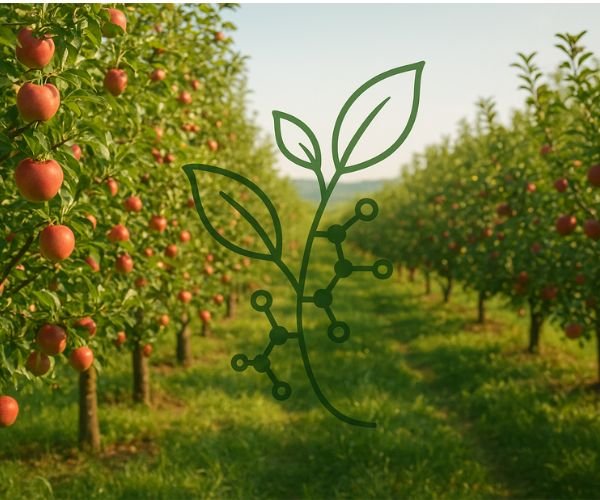Introduction: Amino Acids—Nutrients or Growth Regulators?
Amino acids are widely recognized as essential nutrients that promote plant growth. However, recent agronomic research has revealed another fascinating role—growth regulation.
When used at high concentrations, certain amino acids can control excessive vegetative growth, redirecting nutrients toward fruit development and improving both yield and quality.
For growers who are frustrated by uncontrolled shoot growth or poor fruit set, amino acid-based growth control offers a safe and natural alternative to traditional chemical growth inhibitors.
1. Why Choose Amino Acids for Growth Control?
In modern orchards and vegetable fields, managing plant vigor is a constant challenge. Excessive shoot growth leads to shading, poor fruit coloration, delayed maturity, and nutrient imbalance.
Traditional methods rely heavily on chemical regulators or synthetic hormones, which often come with strict dosage limits, potential phytotoxicity, and residue concerns.
Amino acid-based growth control emerged as a new-generation solution that combines efficacy and safety. Unlike hormones or inhibitors, amino acids are natural plant metabolites. They act by temporarily adjusting internal metabolism, not by forcing suppression.
This makes amino acids a mild, reversible, and eco-friendly approach for managing plant vigor—aligning perfectly with sustainable agricultural practices.
2. Not All Amino Acids Work the Same: Understanding the Key Players
Amino acids are a large family—more than 20 types—each with distinct physiological effects.
Their role in growth regulation depends on both type and concentration.
➤ Growth-Inhibiting Amino Acids (“Regulatory Core”)
-
Cystine (Cys)
-
Methionine (Met)
-
Tyrosine (Tyr)
-
Phenylalanine (Phe)
At high concentrations, these amino acids can effectively suppress excessive shoot growth and promote tissue maturation.
➤ Weak or No Regulation Effect
-
Alanine (Ala)
-
Glutamic acid (Glu)
Even at high concentrations, these primarily serve as nutrients rather than growth regulators.
➤ Growth-Promoting Amino Acids
-
Lysine (Lys)
At low concentrations, Lysine stimulates cell division and germination, enhancing vegetative growth rather than controlling it.
👉 Conclusion: Selecting the right amino acid type is the first step to successful and safe growth regulation. Always choose formulations containing the key “growth control” amino acids above.
3. How Do High-Concentration Amino Acids Control Growth?
The mechanism is subtle yet scientifically grounded—it’s not toxicity, but metabolic balance adjustment.
(1) Disturbing Metabolic Pathways
Applying high concentrations of specific amino acids alters the equilibrium of plant metabolism. For example:
-
Methionine (Met)
Acts as a precursor for ethylene, a hormone that promotes maturation and inhibits shoot elongation. Supplementing extra Met increases ethylene synthesis, leading to controlled shoot growth. -
Phenylalanine (Phe)
Is a precursor for lignin and anthocyanins. It promotes lignification (hardening) of new shoots, helping them mature faster and shift from vegetative to reproductive growth, resulting in more flower and fruit formation.
(2) Temporary and Reversible Effect
The growth suppression caused by amino acids is temporary.
As the plant metabolizes the excess amino acids, internal balance is restored and normal growth resumes. This reversible regulation ensures plant safety and prevents permanent damage.
4. Practical Guide: How to Use Amino Acids for Growth Regulation
To achieve optimal results, correct type, concentration, and timing are essential.
✅ Choose the Right Product
Select high-concentration amino acid formulations based on methionine, phenylalanine, or cystine. Avoid general-purpose amino acid fertilizers intended only for nutrition.
✅ Control the Concentration
“Dilute rather than overuse” is the golden rule.
Different crops have different tolerance levels. For example:
-
Fruit trees (such as peach, cherry): 50–100× dilution may be effective and safe.
-
Vegetables or young seedlings: require much lower concentrations to avoid phytotoxic effects.
Always follow product instructions and conduct a small-scale test before full-field application.
✅ Apply at the Right Growth Stage
Timing determines success. The best period for amino acid growth control is:
-
Early vegetative stage: when new shoots begin to elongate.
If applied too late, when excessive elongation has already occurred, the control effect will be weaker.
✅ Make Use of the “Side Benefits”
After applying high-concentration amino acids, vegetative growth slows, but nutrient flow toward fruits increases.
This results in larger, sweeter, and higher-quality fruits, fulfilling the dual goal of balanced growth and high yield.
5. The Science and Art of Balance
Amino acid-based growth control represents a balanced and intelligent farming philosophy.
It respects plant physiology, using natural compounds to guide rather than force growth behavior.
Unlike synthetic hormones, amino acids act as gentle regulators, telling the plant:
“It’s time to stop growing taller—and start focusing on flowering and fruiting.”
This modern approach bridges the gap between nutritional management and physiological regulation, offering growers a safe, sustainable, and effective tool to manage crop vigor.
Key Takeaways
| Category | Function | Example Amino Acids | Effect |
|---|---|---|---|
| Growth-Inhibiting | Control excessive shoot growth | Methionine, Phenylalanine, Tyrosine | Compact plant structure, enhanced fruit set |
| Nutritional | Promote general growth | Glutamic acid, Alanine | Increased chlorophyll, stronger metabolism |
| Growth-Promoting | Stimulate sprouting and division | Lysine | Enhanced vegetative growth |
As agriculture shifts toward sustainability, the use of natural biochemical regulators such as amino acids is becoming increasingly important.
High-concentration amino acid regulation provides growers with a safe, residue-free alternative to chemical growth inhibitors—delivering healthier plants, better fruit quality, and higher yields.
By understanding and mastering this “dual role” of amino acids, growers can achieve more precise control over plant growth, leading to smarter, more efficient farming.
Wellyou Tech — Your trusted partner in innovative agrochemical solutions.
We provide high-quality amino acid-based fertilizers and growth regulation technologies designed to improve plant performance naturally and sustainably.


